In addition to his pivotal role at LA Country Club and the SCGA, Ed Tufts was also the head of the Pacific Coast Golf Association and later the California Golf Association, and that was in addition to his civic commitments. Renaissance man!
Category: Los Angeles (L.A.) Open
Robert “Bob” Lunn at Rancho Park
In 1971, the 45th Los Angeles Open was renamed the Glen Campbell Los Angeles Open.
According to course manager Si Wasserman, the Rancho Golf Course was in the middle of $300,000 worth of major improvements. Tee’s were enlarged and re-seeded; a new driving range fence was installed with sound baffles; and six new “sand traps” were added “to make an already difficult course even more challenging,” and the Rancho restaurant was renovated to be “on a par with the finest of any public facility.”
“Some 70 palm “trees” have been placed at strategic spots to improve the landscaping. Hundreds of young trees have been planted at appropriate locations to provide a beautiful background.”
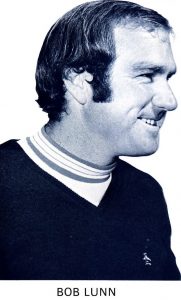
San Francisco municipal golfer Robert “Bob” Lunn had missed a playoff with Billy Casper and Hale Irwin in the 1970 L.A. Open by one stroke and was ready for another chance in 1971. Coincidentally, Lunn won the USGA Public Links championship in 1963, the same “major” that Rancho had hosted for its grand opening in 1949.
Note: For all professional golf competitions at Rancho Park the nine’s were reversed.
From the 1972 Glen Campbell Los Angeles Open Press Book:
RESUME OF THE 1971 LOS ANGELES OPEN
The tradition-rich Los Angeles Open has seen surprisingly few playoffs during its 45 years. But the law of averages has begun to catch up in the last three years, each of which produced a sudden-death playoff.In 1971, Bill Casper, who won such a decider from young Hale Irwin in 1970, lost out to husky Bob Lunn in a tense, four-hole playoff.
Lunn 25, and the veteran Casper, 39, tied at the end of the regulation 72 holes with eight-under-par 274s. Veteran Art Wall almost made it a three-way playoff but three-putted the 72nd hole to finish one shot back of Lunn and Casper.
The Lunn-Casper playoff started on the 15th hole and they battled all the way to the 18th before a decision was reached. There, Lunn put his approach shot 18 inches from the flag while Casper was on the back of the green.
Billy made a good attempt for his birdie but just failed. Lunn then rolled in the putt to take the $22,000 first prize and another big step in his career.
(From the 1972 L.A. Open Press Book.)
The 1971 Open was close and competitive all the way. Virtually unknown Bobby Greenwood led by three shots entering the final 18 but couldn’t handle the pressure and slipped to a 73, which netted him a tie for fourth place.
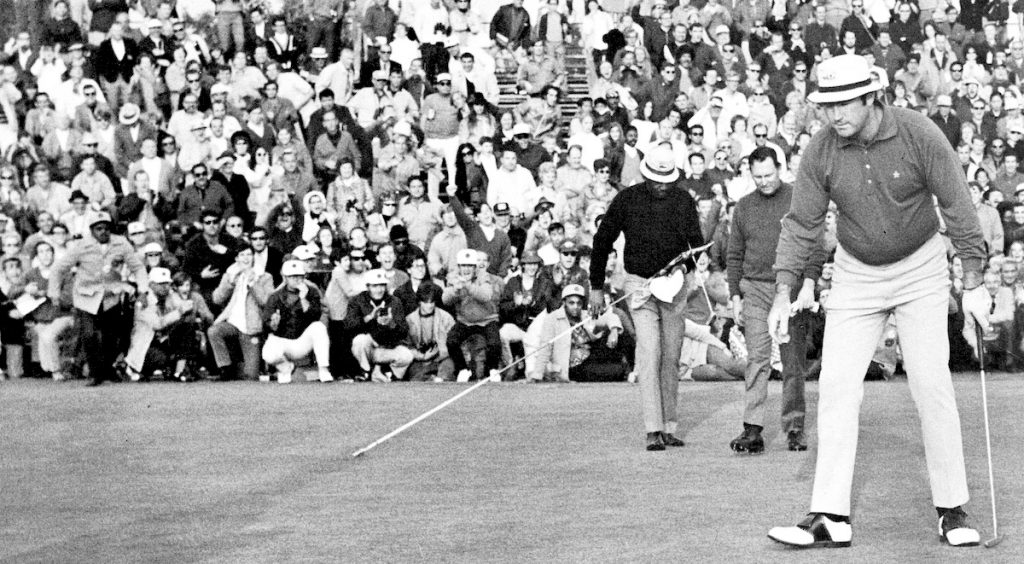
Here is Bob Lunn’s story by Shav Glick, from the 1972 L.A. Open program:
BOB LUNN – DEFENDING CHAMPION
At first glance Bob Lunn appears to be a big, burley fellow who could pass for the town bully in a “B” Western.
But he’s really as emotional as a puppy.
Bob’s first win on a golf course came when he was an 18-year old public links golfer from Sacramento. He won the 1963 U.S. Public Links championship on the Haggin Oaks Course in his hometown, defeating Steve Opperman, 1 up, in the finals.
“When that last little putt dropped into the cup,” said Lunn, I couldn’t keep the tears back. And l thought I was going to be sick.”
A few years later he was making $100,000, on the PGA tour, but he hadn’t lost his sentimental altitude.
Last January, after defeating defending champion Billy Casper in a sudden-death playoff for the Glen Campbell Los Angeles Open here at Rancho Park, he was the same old Bob Lunn, a little older and a little bigger, but still the same.
“I’m so happy I could cry – and I probably will,” he said as he accepted a check for $22,000 from Los Angeles Junior Chamber of Commerce officials.
Lunn’s entry into professional golf was as uneventful as his high school career when he didn’t win a tournament. In his first year, 1967, he played in 27 events and won only $1,871 in “official” money. However, he picked up a nice “unofficial” check for $ 6,660 when he teamed with another rookie Rich Martinez of San Clemente to finish second in the Haig and Haig Scotch Foursome tournament.
His success in the November Haig and Haig at La Costa carried over into 1968 when Lunn soared into the $ 100,000 bracket and, was selected by Golf Digest as the “most improved professional of the year.” Bob started off with a fourth place finish in the Andy Williams San Diego Open, worth $7,500, but he won money in only three of his first 12 tournaments. Then, in May, he won back-to-back tour victories at Memphis and Atlanta, becoming the first player in history to follow his initial tour victory with another the following week.
Buoyed with confidence from his fine sophomore year, Lunn started 1969 by winning the $ 31,000 Southern California Open at Los Coyotes. It was the start of another big year for the big fellow from Sacramento. In 1970 he earned $101,685, his second year over the hundred thousand figure.
During the Glen Campbell L.A. Open last year Lunn decided that too much of his earnings were going to his waistline. He had ballooned to 240 pounds during the holiday season and he felt a diet was necessary.
“The extra weight didn’t hurt my game in any way that l could tell,” said Lunn, “but l figured I didn’t need it. l was afraid from a health standpoint.”
Lunn lost 10 pounds during the four rounds here at Rancho and decided that, as long as he won the tournament, he would lose some more. Pretty soon it developed into an obsession and by mid-April he was down to 175 pounds.
“While I didn’t notice any appreciable change in my game, I couldn’t relax off the course,” he admitted later. His wife, a beautiful brunette named Angie, noticed the difference. “He’s too quick to snap at little things.” she confided. “He’s just not like himself .”
When things go wrong for Lunn he turns to Tom LoPresti, the man who gave him his start as a professional, backing him to the tune of $ 250 a week during the early years.
Lunn called LoPresti in Sacramento when the tour reached Atlanta and Tom, a former pro himself, flew to Georgia to help straighten him out.
“After I played one round with Bob I knew his game had gone to pot. He wasn’t consistent off the tee, he shanked some shots and he couldn’t concentrate at all on the greens. I figured he’d lost too much weight too fast and I talked him out of his diet. I convinced him to start eating again, especially foods heavy in dextrose and protein.”
Now Bob is back up close to the 200 pound mark again and hitting the ball with his high, wide and handsome swing. He finished second in the Heritage Golf Classic last month to lift his earnings to $ 82,179 for 1971.
Lunn has had little difficulty preparing himself for defense of the Glen Campbell Los Angeles Open. He is one who loves to practice.
“When l’m not in a tournament I play only about 18 holes a week, but I try to get in at least two hours of practice every day,” he once said. “That’s just as much fun as playing. I love to just stand there and hit those balls.”
He hits them a long way, too. In a stretch of 21 tournaments where IBM charted every drive of every professional, Lunn averaged 268 yards. Only DeWitt Weaver, Jack Nicklaus and Marty Fleckman were longer.
Now that Bob’s weight is back up, there’s very little to distinguish him from the young fellow who started out on the tour six years ago – except his bankroll. Once Bob was asked what difference success had made to him.
“It’s funny, the other guys are letting me tell my stories now. They used to bore me with their own,” he answered.
If he can win the Glen Campbell Los Angeles Open again this week he’ll have a whole lot more to talk about. No one has scored back-to-back wins in this tournament since Arnold Palmer accomplished the feat in 1966-67.
And if he does, he’ll probably cry, too.
Shav Glick, from the 1972 L.A. Open program
©2022 Jib Jones golfhistoricalsociety
125 Years of Griffith Park. 107 Years of Golf
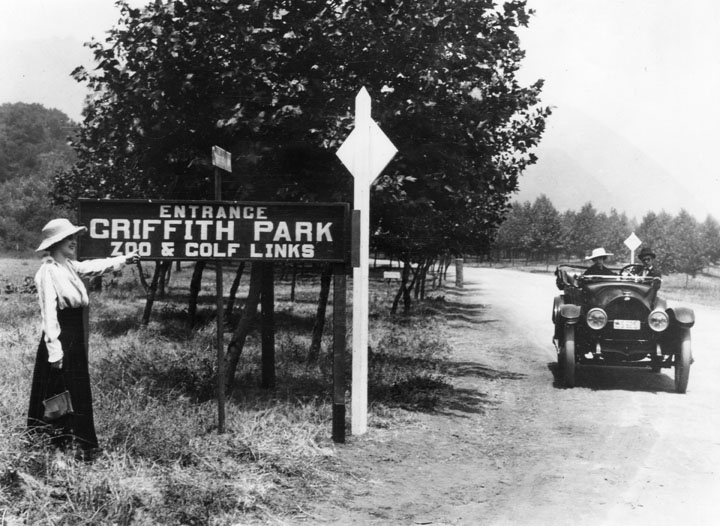
Griffith Park was donated to the city of Los Angeles by Griffith Jenkins Griffith and his wife Christina Mesmer Griffith at Christmas of 1896. This November 13 the Recreation and Parks Department are celebrating the 125th anniversary of that gift.
The first Griffith Park municipal golf course, No. 1, opened on November 1, 1914, with the support of members of the Los Angeles Country Club and the Southern California Golf Association. It was a sand green links designed by golf legend Tom Bendelow and was located under Wilson #1,2,18, and Harding #17 and 18, west of the old city water pipe.
The old links were much loved by the country club crowd. They were also the site of many a film star hitting balls between takes. Griffith Park was location #1 in the late teens! Many athletes, celebrities, and other sports stars visited Los Angeles in the winters. Babe Ruth even signed his Yankee contract while playing Municipal No. 1 in 1920.
In 1923 George C. Thomas Jr., designed new municipal, No. 2, Harding Memorial, and in 1927 the Wilson Memorial, both all-grass golf courses. Nine holes of the old sand course, which are now part of the Zoo, were kept, and grassed-over in the 1930’s, and renamed the Roosevelt Memorial Golf Course.
In the early 1930s, superintendent of golf, William Johnson, and architect William P. Bell, modernized the courses using Federal Works money, installing irrigation and building the current clubhouse by 1936. It replaced the English style field house of 1918. Both Wilson and Harding courses were used for the L.A. Opens of 1937-1939.
After the great flood of 1938, the L.A. River was channelized to protect the park from flood damage. The county road was built in the 1920s along the river bank, and their “right of way” became the battle over the 5 Freeway in the late 1950s. The golf holes along the county road were taken during construction, but the land was returned afterward, with new holes designed to replace them.
Later, Wilson lost three more holes that became the Crystal Springs picnic area. There is also an old par 3 that had been the 18th and then the 16th hole on Thomas’s Harding, located between the 1st and 17th holes, which was abandoned in the 1950s.
In the early 1960s the city of L.A. wanted a new Zoo, and decided to replace the old Roosevelt golf course. The uproar caused the construction of the new Roosevelt golf course in Vermont Canyon, which was built to replace the historic remnant of the original 1914 Municipal No. 1. Both courses were open on the same day in 1964, after which the turf grass from the old course was spread around the city’s other courses.
Griffith Park was also home to the Coolidge Memorial course, now called the Tregnan Academy, the Los Feliz driving range and Par 3 course, and the nine-hole putting course on the second floor of the Griffith Park Bath House.
Los Angeles Recreation and Parks should be very proud of their accomplishments, having turned the original 18-hole sand course into a golf system that today has twelve courses that have been funded by the receipts from Griffith Park and later Rancho Park.
Come out on the 13th of November and enjoy the beautiful gift of the park and all of the awesome facilities that we in Los Angeles are so proud to have!
©2021 jib jones – golfhistoricalsociety
Tiger Pines – the 2008 U.S. Open
by J.I.B. Jones
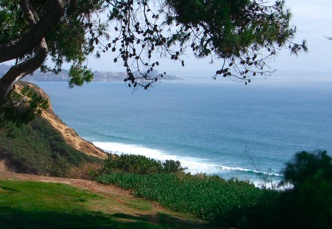
In mid-June 2008 I took the Pacific Surfliner train along the coast from Los Angeles to Rancho Santa Fe and thence to Torrey Pines for the 108th U.S. Open golf championship. I was a guest of the U.S.G.A. after having helped Pete Georgiady research for his article about public golf on the west coast in the official 2008 U.S. Open Program. Pete’s story opened with my story of baseball legend Babe Ruth signing his Yankee contract at Griffith Park’s original 18-hole Municipal Links in January 1920. Griffith Park later hosted the Los Angeles Open from 1937-1939 on both George C. Thomas Jr., designed courses. They were remodeled and toughened up in the 1930’s by Billy Bell and Bill Johnson with Works Progress Administration funding in anticipation.
Los Angeles’s other municipal gem is the Rancho golf course where the Open was also held from 1955-1972, and in 1983 when the Riviera Country Club held the P.G.A. championship. Rancho’s most memorable moment, as chosen by the editors, was Arnold Palmer’s 12 during the first round of the 1961 L.A. Open. Nevertheless, I’m more than pleased to have my name in print as the Rancho Park Golf Club historian. Thanks to everybody in the club for being a part of it, and to L.A.’s Recreation & Parks Golf Division for recommending me to Pete!
As I was lucky enough to be staying in Rancho Santa Fe with a great friend, I was able to take the volunteer shuttle from the polo grounds to Torrey Pines all week with no hassle. The U.S.G.A.’s organization was spectacular, and no matter what the armchair golf architects think about Torrey Pines’ value as a golf course, Riviera could never host a US Open without a second course for practice and staging and large crowds of spectators. Well, I guess they could if they closed Brentwood, and maybe Bel-Air, and filled them with tents, and shuttled people by helicopter like they do at Grand Prix races!
Unfortunately, the U.S.G.A. didn’t have time to do any historical research on Torrey Pines. In fact, in their display of future US Open venues — in the American Express tent — they wrongly credited Chandler Egan with changing the 18th at Pebble Beach into a par 5. We at Rancho, and Neal Hotelling (the official historian of Pebble Beach), know that it was LACC and Rancho’s own W. Herbert Fowler who made the changes in 1921, the same year he finished designing the original Rancho-Ambassador course, and the Los Angeles Country Club’s North and South courses.
As is my custom, I told everyone that I met about Torrey’s history, even though they were mostly interested in a certain golfer from Cypress, California…
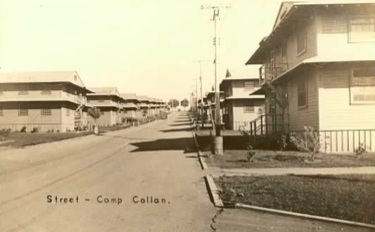
Camp Callan – Torrey Pines South during WW II
For the record, Torrey Pines was given to San Diego in 1908 by Ellen Scripps, the most amazing philanthropist California has ever known. Miss Scripps, along with her sister Virginia, bought every acre of Torrey Pines to stop development, and then donated it to the City of San Diego to be protected and used as a public park. During World War II it became Camp Callan, the Coast Artillery Corps base, then a Sports Car Club of America race track, and then finally the Torrey Pines golf courses.
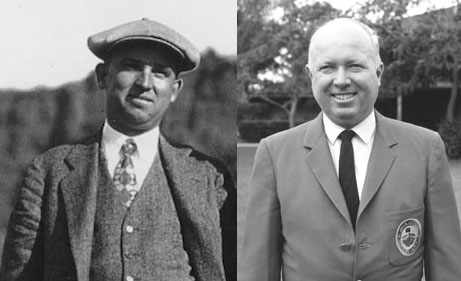
Billy Bell and his son Billy Jr.
William P. “Billy” Bell, who designed, co-designed, or constructed the majority of the great Southern California golden era golf courses before his untimely death from a heart attack in 1953, had the original vision for Torrey Pines. His equally prolific and brilliant son William F. Bell (Billy Jr.) made his father’s vision a reality by completing the designs in 1955 when he began construction of the golf courses.
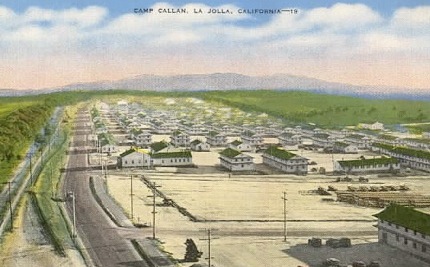
Camp Callan postcard – Torrey Pines South during WW II
Billy Jr. shaped the mostly flat landscape into the rolling land of the Torrey Pines we know today by using the many acres of asphalt roads, parade grounds, and even the foundations of the camp buildings, piling the rubble to shape the courses. Truly a pair of genius’ at work!
Torrey Pines South course opened in June 1957 with an exhibition that included 1934 Rancho golf course professional Ralph Guldahl, winner of the 1937-38 U.S. Open and the 1939 Masters.
In 1972 golf course architects David Rainville and Billy Casper did a major remodeling job which included recontouring the greens. More recently, Rees Jones improved the layout tenfold in preparation for the 2008 US Open. The local club golfers I met over the week were amazed at how beautiful Rees had made their golf course.
Maybe we can use Hillcrest for the extra tents and host the US Open in 2024 at Rancho Park!
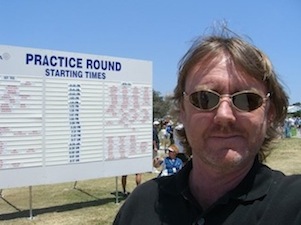
Jones during U.S. Open practice at Torrey Pines
Back to the 108th US Open.
The rough during the practice rounds was all anybody needed to see to know that hitting fairways was going to be the name of the game at this Open. Unlike the Masters, getting up and down wasn’t the hard part. Narrow fairways made it paramount to be in the fairway. Even the short rough made hitting the green unlikely and a bogey likely. Many players also seemed to be caught off guard by the fluffy sand traps and the slowness of the greens the first couple of days compared to expectations.
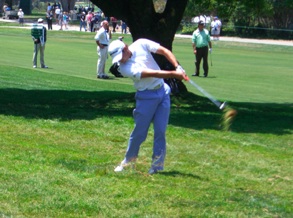
Sergio Garcia didn’t get this one (or the next 2) out of the second cut on 14 on Wednesday.
The U.S.G.A.’s scoring prediction was right on. They got what they wanted and the spectators and TV viewers were treated to some brilliant golf. Even the best drivers of the ball ended up in the rough and paid the price. How Tiger won while missing so many fairways says volumes about the quality of his short game and his superhuman strength from the rough. Even though we always go on about his awe-inspiring swing, he really is also as good as the best putter who has ever lived — and his ‘drive’ to win is unequalled.
There were many highlights of my week, including seeing former S.C.G.A. President Ed Holmes scouting the course for the TV announcers, and meeting up with legendary golf course supervisor Ted Horton (C.G.C.O.A.), Kevin Heaney (S.C.G.A.), Craig Kessler (P.L.G.A.) and U.S.G.A. President Jim Vernon and his assistant Ashleigh on the North Course, away from the action, for a photo shoot celebrating Golf Week in California.
The most impressive feat of the event, without a doubt, were the thousands of volunteers who came from all over America and across the world to work for their clubs and charities, helping to raise millions for their communities. It really is the pinnacle of dedication and charitable giving by the volunteers, and the U.S.G.A. should be praised for using their championships this way.
I was so lucky to have been a part of the 108th US Open. Thank’s Pete and Kevin! I did it wearing my Rancho Park logos in full view on the various shirts and visors I wore all week.
Next up for us in California – Pebble Beach 2010.
All photos and words Copyright 2008-2014 JIB Jones Golf Historical Society
Not to be reprinted without permission.
Arnie Palmer and his infamous 12
by J.I.B. Jones
February 9, 2021
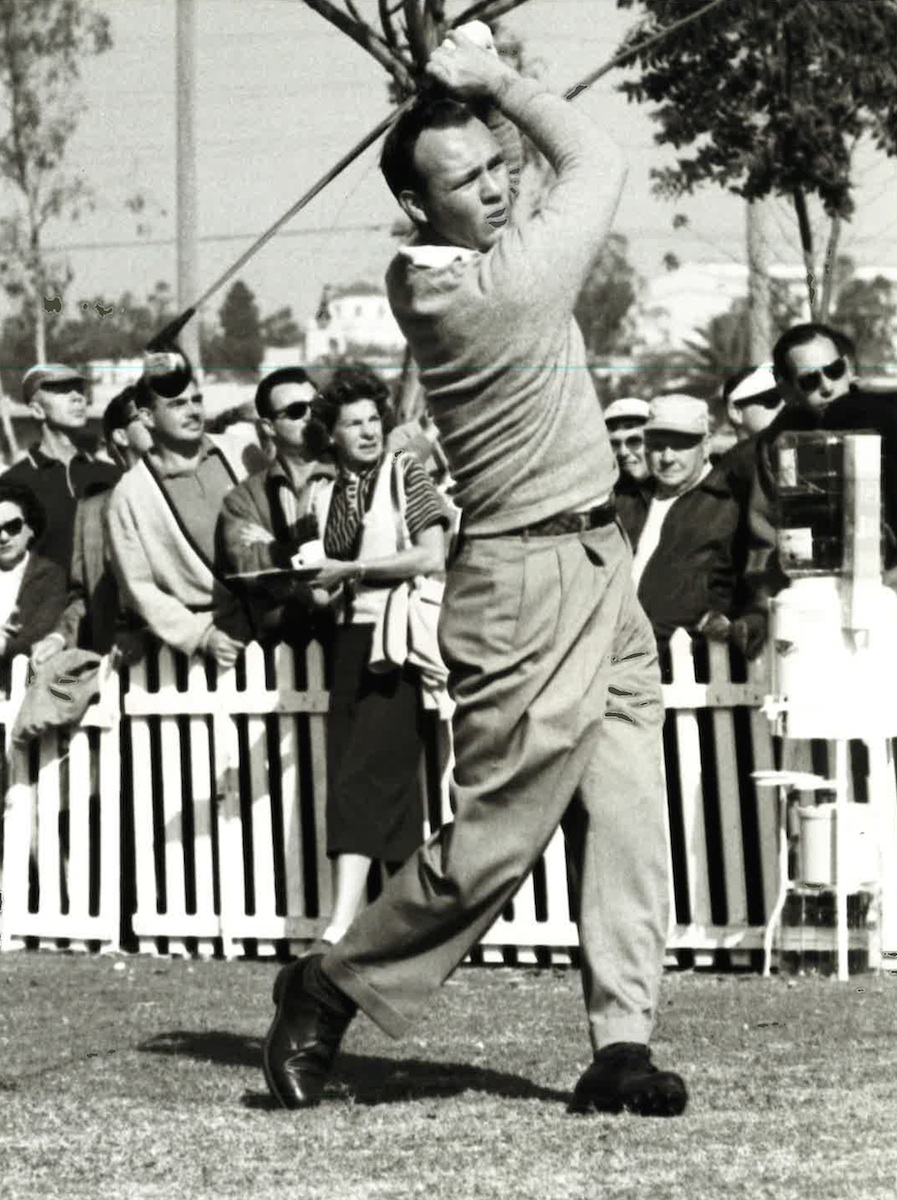
Today we’re looking back 60-years to the 35th Los Angeles Open at Rancho Municipal Golf Course and remembering the 12 that shook the world! The one scored by the late great, handsome, swashbuckling golfer, Arnold Palmer, on his 18th hole of the 1961 tournament.
I also want to share with you how Arnie’s story has been remembered over the years, so, after the “overview” you will find selected quotes from various news sources describing how he got the 12. Arnold himself was asked about it more than a few too many times!
Overview
The 35th Los Angeles Open (“Golf’s Golden Tournament”) was presented by the L.A. Junior Chamber of Commerce and the Southern California Professional Golfers Association. The Rancho Municipal Golf Course measured 7,131 yards and was a “par” 71. The professionals played the course with the front and back nine’s reversed, starting at the regular 10th hole. And like today, some players started on the 1st, and some on the 10th. Also traditional at Rancho for the Los Angeles Open, the Open was played from Friday to Monday. Thursday was Pro-Am day. Television forced the Thursday-Sunday change in 1966.
Interestingly Arnold Palmer “tee’d off” on the 10th, the regular 1st hole, on Friday at 12:14 P.M., playing with Billy Casper (71) and Bo Wininger (74). When he reached the 508 yard par-5 eighteenth hole he needed “par” to finish one-under 70 and stay in contention, but he spoiled it.
Palmer’s drive was perfect and went 270 yards to the middle of the fairway, leaving him a 238 yard uphill shot to a raised green at the end of a 50 yard-wide funnel of “Out of Bounds” fences.
For his second and fourth shots Arnie hit over the 25 foot high driving range fence on the right, and then put his 6th and 8th shots into the middle of Patricia Avenue on the left, with one ball crossing Pico Boulevard. For his 10th stroke he ended up over the flag on the apron of the green on a downhill lie. His approach was short, and his one-putt earned him the 12, scoring 77 for the round. It put him 10-strokes behind the leader Ted Kroll, and led to him missing his only cut of the year by one stroke when he scored 72 in Saturday’s second round.
After the L.A. Open Arnie sped off to San Diego and won the tournament, followed by wins at Phoenix, Baton Rouge, Texas, and topping off his summer by winning the Open Championship at Royal Birkdale in England.
The Stories
1961 01 07 – LA Times – Dick Hyland says: R, R, L, L
“Palmer took a 3-wood and swung. The ball shot straight as an arrow, high and to his right – six feet out of bounds over the 25 foot fence guarding the driving range.
Palmer dropped a ball, swung again. Again out of bounds. Same place.
Again he dropped a ball. Palmer corrected his grip and stance. Overcorrected. Bang. Out of bounds again, this time hole high over the grandstand and 30-ft high fence bordering Patricia Ave.
Palmer did not hesitate. He dropped another ball over his shoulder, stepped back, addressed the ball – and hit it out of bounds behind the stands again!
The fifth ball he played on the hole, for his 10th shot, Palmer slapped past the pin onto the green, the first player to hit past the pin on the long hole all day. The ball trickled a foot off the far side of the green onto the apron 25 ft. from the pin. Palmer finally went into the cup with his 12th stroke.
‘A nice round number.’ he mumbled writing it on the card. The crowd cheered him loudly.
‘What were you trying to do?’
‘I was just trying to get the ball on the green.’
‘What happened?’
‘I just hit some bad shots.’ “
1961 01 07 – LA Times – Paul Zimmerman says: R, R, L, L
“He pushed his first fairway shot over the fence into the driving range. The second went the same place, as Arnold struck with his No. 3 wood.
Boom! went the third high over the screen onto Patricia Ave., as he hooked badly trying to adjust. The fourth one looped into the same place and rolled to Pico.
‘What were you trying to do?‘ someone asked naively.
‘I was just trying to get the ball on the green,‘ was Palmer’s retort as a thin grin broke across his handsome face.“
1961 01 07 – NYT – Arnold Palmer Says: R, R, L, L
“ ‘I pushed a No. 3 wood out of bounds into the practice fairway the first time. Then I pushed another one about in the same spot.‘
‘It is possible I over corrected on the third one and knocked that clear out of the course on the opposite side of the fairways and clear out on the highway. The fourth one went right with it.‘
‘It was a nice round figure, that 12,‘ he quipped as he walked off the El Rancho course, appearing only slightly perturbed.”
1965 01 07 – LA Times – Bill Shirley says: L, R, L, R
“He knocked his second shot out of bounds to the left, dropped another ball and hit it out of bounds to the right…He tried again – and hit another shot out of bounds to the left. Shot No. 5 sailed out of bounds, this time to the right again, presumably to keep the score even.”
1967 01 27 – LA Times – Charles Maher says: L, R, L, R
“On his second shot…Palmer hit a ball right down the middle. That is, it was right down the middle of Patricia Avenue, which borders the course on the west.
Palmer then shot out of bounds on the east side, knocked another ball onto Patricia Avenue, went out of bounds once more in the east…”
1968 01 21 – LA Times – Patrick McNulty says: L, R, L, R
“Palmer blasted off with another power shot that carried 250 yards. Unfortunately, the shot hooked badly, finally bouncing out of bounds on the road.
Then: Whammo! another Palmer shot, this time slicing over into the driving range…dropped another ball. Incredibly this ball too began curving left, falling into the street…Another ball and another slice…”
1982 01 13 – UPI – Plaque says: R, R, L, L. – Palmer says: R, L, L, R
“A permanent plaque describes the 12 as follows: After hitting a perfect drive, Palmer sliced two balls into the driving range and followed with two hooks onto Patricia Avenue, which runs alongside the ninth fairway. He reached the green with his 10th shot and two-putted for his 12.
Palmer, understandably, says he doesn’t remember all the details of the fateful day in the first round of the 1961 tournament. But he said the plaque is wrong.
‘After a pretty good drive, my next shot, a 3-wood, hit the top of the fence before going into the driving range,’ he said. ‘Then my next shot hooked over the fence. I think my next shot went left, too, then the next one went to the driving range again.’ “
1983 01 13 – LA Times – Shav Glick – two right, two left
Palmer – “ ‘The plaque is wrong, though, it wasn’t the first round, it was the second round.’ “
1987 07 18 – Washington Post – Arnold Palmer says: L, R, L, R.
“I took 12 on a par-5 in the L.A. Open once: I wanted to knock a 3-wood on the green, but put it out of bounds to the left. I hit it again and put it out of bounds on the right. Then the left again, and then the right again. A guy in the press asked me, `How’d you make 12?’ {Pause. Wink.} I said I missed a 20-foot putt for 11.”
1990 10 25 – LA Times – Dan Hafner – Palmer says: R, L, R, L.?
“It was Palmer’s last hole of the second round on Jan. 6, 1961. He drove the ball 275 yards up the middle of the fairway.
‘The plaque says it was the first round, but it was the second,‘ Palmer recalled. ‘I knew that I needed a birdie for a 68, and an eagle would put me close to the lead.‘
‘I went for the green in two, using a three-wood. It soared over the fence into the driving range.’
Asked why he didn’t then play it safe, Palmer said, ‘Well, I still had a chance to make par.’
Palmer hit the next shot into the road on the left, then stubbornly hit two more out of bounds.
‘I had to make a tough putt just to get my 12,’ he said, laughing. ‘Instead of being close to the lead, I missed the cut.’
‘I think you could say there was no lasting effect. I won the next two tournaments on the tour and then had three winning tournaments at Rancho in future years. I’ve always enjoyed playing there.’ “
1991 04 07 – LA Times – Mal Florence – Palmer says: 4 balls out of bounds
“He then proceeded to hit four balls out of bounds and missed the cut.
‘I was devastated,’ he said. ‘I went to the VIP tent and ordered a beer. I was mulling over what happened, and J. Paul Getty was in there and he said. ‘How in the world could a player of your caliber do that?’ I said, ‘Well, I missed a 20-foot putt for an 11.’ ”
1993 10 17 – OC Register – John Strege – Palmer says: R, R, L, L
“Palmer put his drive in the fairway, then pushed his next two shots right, into the driving range. He hooked two shots out of bounds, onto Patricia Ave. He then hit the green and took two putts.
Later he was asked how he made 12.
‘I missed a three-footer for 11,’ he said.”
2014 05 08 – TV Week – Chuck Ross – Palmers says: R, R, L, L
“ ‘…pushed the first two shots – hooked two onto road.’ ”
Arnie Palmer and his infamous 12 by J.I.B. Jones
©2021 JIBJONES Golf Historical Society
71 Years of the Rancho Park Golf Course!
Rancho Municipal Golf Course opened on July 3, 1949, with a Bob Hope exhibition, followed by the U.S.G.A. Public Links championship, and has continued to host numerous golf championships on its hallow green ever since.
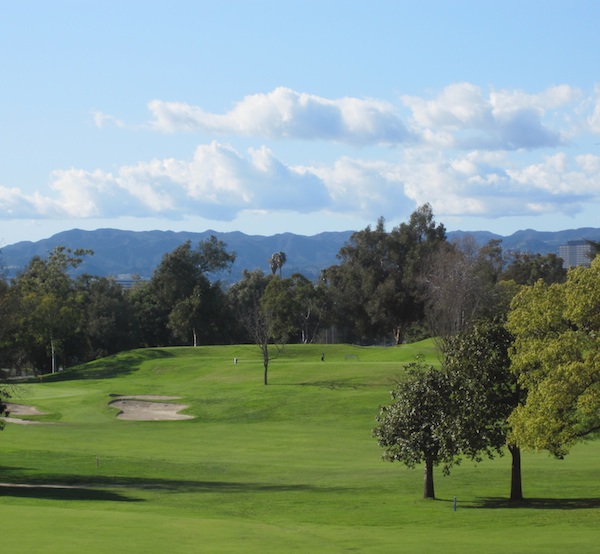
Always one of the busiest golf courses in America, Rancho’s rolling hills, lofted trees, wide fairways, minimal rough and small greens, can still challenge and enchant, despite existing in a playing condition more akin to the 1980s than television golf.
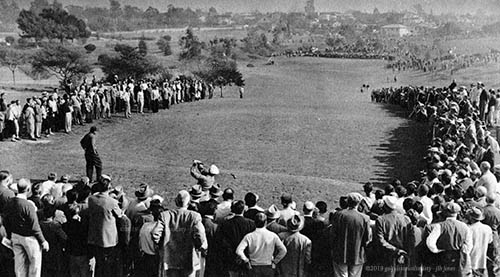
The Los Angeles Open was held at Rancho between 1956 and 1983, when it was a major civic event, drawing thousands of spectators, and where Arnie’s Army really began.
The Open’s early-January date was the first of the professional season, and often enhanced by fog, wind, cold and rain, making for great competition. When Rancho was in championship form, with double cut greens, deep rough and narrow fairways, the pros almost never “ate up” the course.
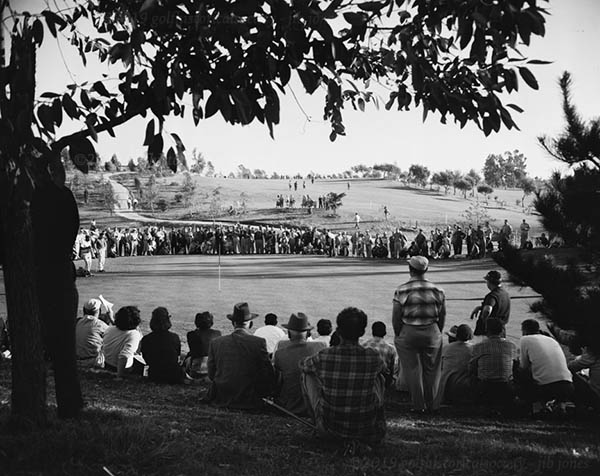
The lowest Los Angeles Open score on Rancho was 268 by 23 year-old Phil Rodgers in 1962, the same year Jack Nicklaus entered his first championship and finished in last place. Rodgers had a 62 in the final round! Phil also won the 1954 Junior L.A. Open at Rancho, beating runner-up and National Junior champion Al Geiberger by seven strokes.
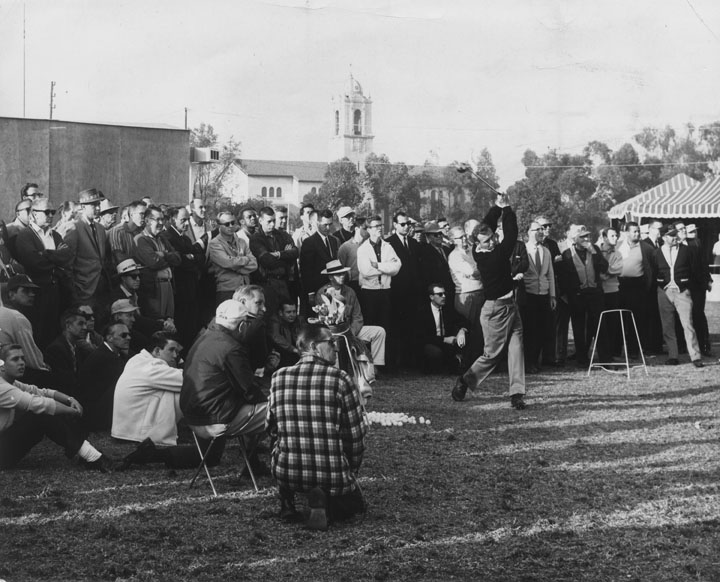
Rancho’s next lowest L.A. Open score was Arnold Palmer‘s 269 in 1967.
Gil Morgan managed 270 in the last L.A. Open at Rancho in 1983. This compares to Lanny Watkins’s record score of 264 in 1985, Fred Couples’ 266 in 1990, and Chip Beck and Mike Weir’s 267 in 1988 and 2004 respectively, all scored on the Riviera Country Club course.
Happy 71st Birthday Rancho!
©2019 golfhistoricalsociety – jibjones – All Rights Reserved.
57th L.A. Open at Rancho Park, Los Angeles
In 1983, the 57th Glen Campbell Los Angeles Open returned to the 6638-yard Rancho Park Golf Course for one year, while Riviera Country Club hosted the PGA Championship.
The L.A. Open was played at Rancho from 1955 to 1972 (minus 1968 at Brookside Park), and most recently in 1983. The Rancho golf course has been home to three permanent golf clubs, and more than 100,000 local and visiting golfers, every year, since 1949. The excitement level of having the professionals at Rancho was always high, with so many of the spectators knowing the course from first hand experience, and the tournament having the full support of the community, and the city of Los Angeles, it isn’t hard to imagine that L.A. Open’s at Rancho were a big success!
In 1983, the pro-amateur featured former U.S. President Gerald Ford, Jack Lemmon, Fred MacMurray, Mike Douglas, Robert Stack, Monty Hall, Dick Martin, Johnny Mathis, Foster Brooks, Scatman Crothers, Wayne Rodgers, Tommy Lasorda, and Steve Garvey, who all entertained the fans.
The professional competition included, Tom Watson, Arnold Palmer, Johnny Miller, Craig Stadler, Dave Stockton, Jim Dent, Lee Trevino, Payne Stewart, Roger Dunn, Charlie Sifford, Jim Thorpe, Bobby Clampett, Roger Maltbie, Larry Mize, Bobbie Wadkins, Fuzzy Zoeller, Mac O’Grady, and others.
53-year old Arnold Palmer opened with a 66, and even led for five holes during the final round! Nowhere on tour has Arnie had more love and support than from his fans at Rancho! And he always deserved it!
Gil Morgan won the title, his second LA Open, scoring 270 over 72 holes.
Previous LA Open winner at Rancho, George Archer, scored a record 61 in the third round, making back to back eagles on No. 8 and 9 (#17 & #18).
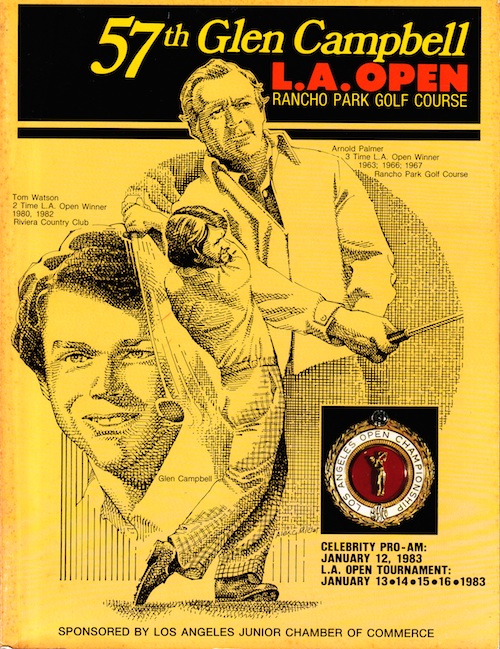
A New Arnold Palmer Plaque Dedicated at Rancho Park Golf Course
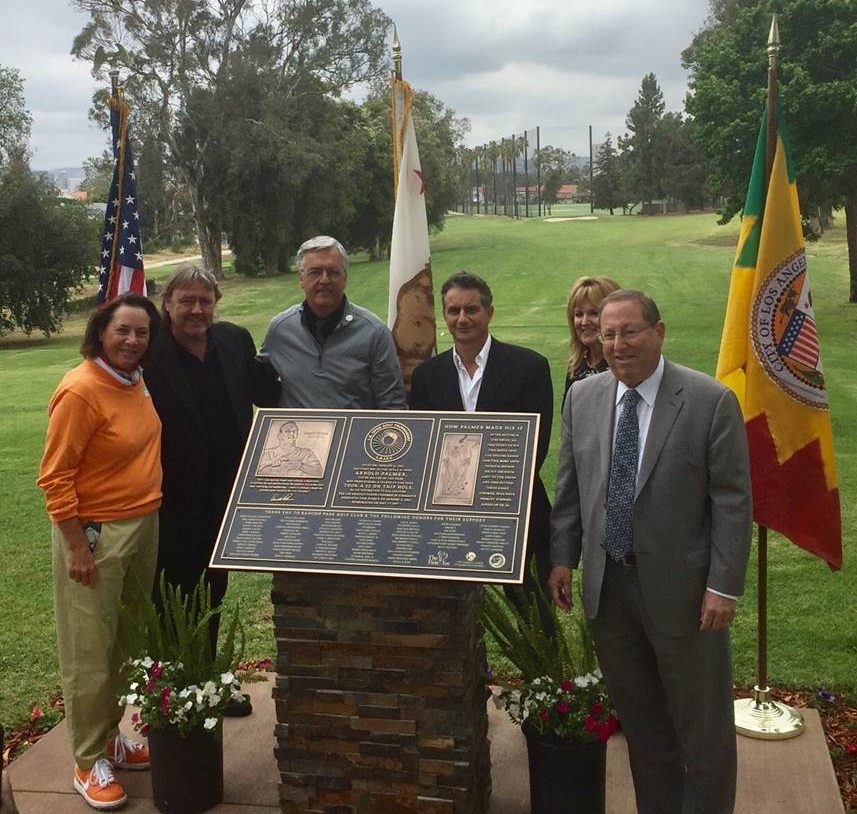
On Wednesday last, a new Arnold Palmer plaque was dedicated, commemorating his score of 12, on Rancho Park’s par-five 18th hole, during the first round of the 1961 L.A. Open. The original plaque was dedicated in 1963, and later stolen. A replacement “stone” was installed by the Recreation and Parks Department.
This beautiful new plaque, designed by graphic artist and Rancho Park golf club champion, Ed Passarelli, is the permanent replacement, being a combination of a re-creation of the original plaque, plus a map of the hole, with a description of the strokes taken by Mr Palmer, plus an embossed photograph.
The idea for replacing the replacement of the original plaque, and the execution of the plan to use it to raise money for junior golf, was all Phil Baugh, of the First Tee of Los Angeles.
Arnold would be proud.
After her speech, golf legend Amy Alcott, tee’d up a ball, and played the 18th hole, with a gallery of supporters and guests, she made some beautiful strokes, easily scoring a par 5, with never an inclination of the “heart warming” 3-woods that Arnold experienced in January 1961!
From left to right in the photo:
- Amy Alcott – LPGA & World Golf Hall of Fame member
- John Jones – Rancho Park GC Historian & Grammy Award winner
- Phil Bough – ED LAJCC Charity Foundation/The First Tee of Los Angeles
- Ed Passarelli – Plaque Designer
- Laura Bauernfiend – Golf Manager, LA City Rec. & Parks
- Paul Koretz – LA Councilmember, 5th District
The 1960 Los Angeles Open at Rancho
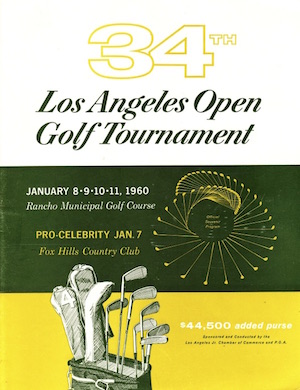
For the sixth Los Angeles Open at Rancho (Park) in 1960, Tournament Director Gene Whitlock allowed the golf course to be re-routed. For the previous five years, the course was played with the nines reversed, but in 1960, while still starting on the back-nine 10th tee, the round finished on today’s par-five 4th hole!
The round started on our 10 (#1), but after 17 (#8), they played 9 (#9), and then played 5 (#10,) through 8 (#13), followed by 18 (#14), 1 (#15), 2 (#16), 3 (#17), and finally 4 (#18)!
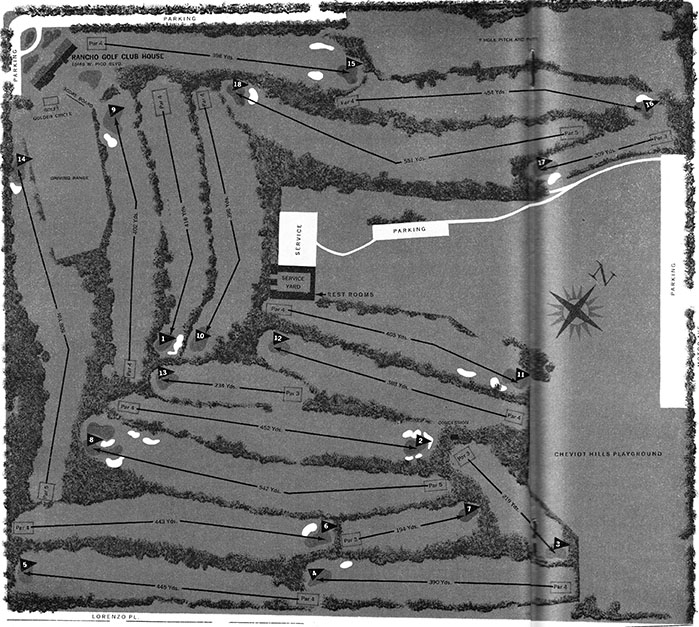
The long walk from the 8th green (#13), to the 18th tee (#14) must have been fun!
“There are shots from that first tee (#15), that go into the gallery at the 4th #(18), and those bleachers alongside 4th (#18) green are going to get a lot of the second shots on that hole.” said Dow Finsterwald in the Los Angeles Times.
Harvey Raynor of the P.G.A., said that the field was the best ever assembled for a Professional Golfer’s event, with 58 winners of PGA tournaments playing.
1960 was the year that California Attorney General Stanley Mosk told the PGA to remove their caucasian-only-clause, if they were going to hold tournaments on public golf courses in the State. Mosk learned about the rule while playing golf with band leader Billy Eckstine and future L.A. Open winner Charlie Sifford, next door, at Hillcrest Country Club.
Ohio University graduate Dow Finsterwald went on to win the rain delayed 1960 Open with 280, after Hillcrest C.C. teaching pro Eric Monti collapsed and shot 80 in the fourth round, having led the first three days!
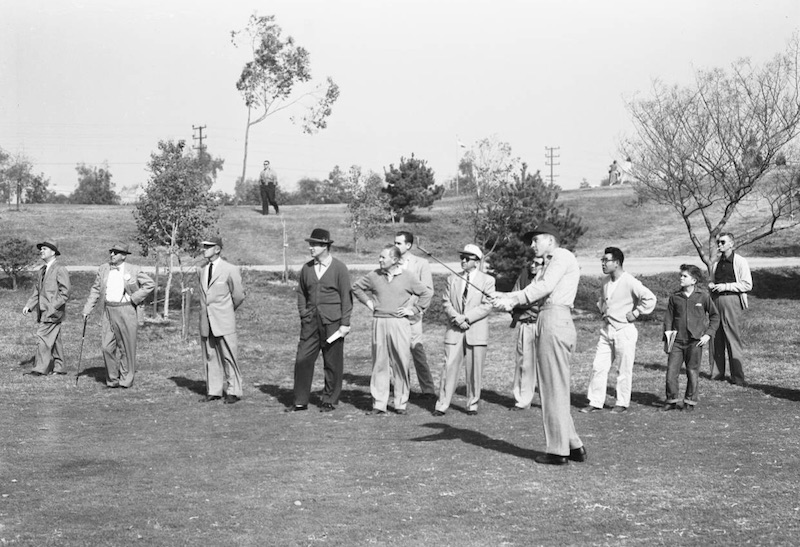
Other moments of madness in 1960 involved the USGA changing “stroke and distance” to “distance only” for a Ball Out of Bounds.
I wonder if the eleven holes on Rancho with out of bounds helped sway their decision? Too bad they didn’t keep the rule for 1961 when Arnold Palmer took his 12 at the 18th!
During 1960, clubs could also enact a local rule allowing players to take a drop near the point that the ball went into a hazard or out of bounds, and add a stoke. The Southern California Golf Association continued the distance-only rule through 1961.
And to make matters more interesting, 1960 was the year of the lively new balls that allowed Mr Palmer to reach the 346-yd. first green at Cherry Hills in the U.S. Open, and also when a seven-handicapper, on the old Roosevelt links in Griffith Park, drove three par-4 greens, and put “a billion and half dollars worth of golf courses in the country” in peril. Sound like today? It was reported at the time that Mr. Palmer actually won the 1960 Masters with a banned ball…
On the brighter side, 29-year old Barbara Eden was LA Open Queen for 1960! Here she is in Jimmy Thompson’s pro shop with L.A. Junior Chamber of Commerce President Bob Meyer.
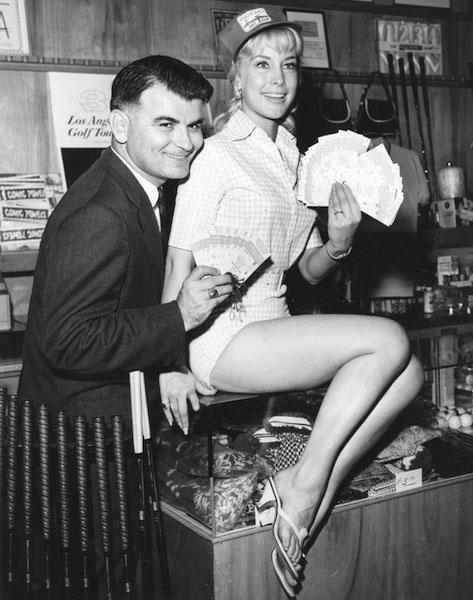
©2016 J.I.B. Jones and the Golf Historical Society.
All Rights reserved.
